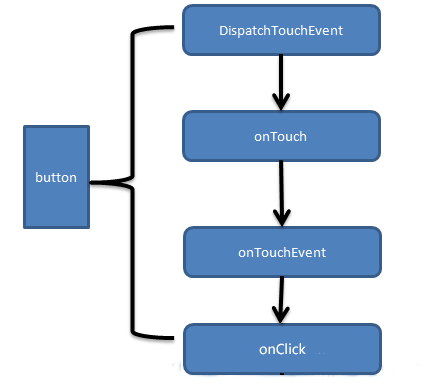touch事件的分发和消费机制
Android 中与 Touch 事件相关的方法包括:dispatchTouchEvent(MotionEvent ev)、onInterceptTouchEvent(MotionEvent ev)、onTouchEvent(MotionEvent ev);能够响应这些方法的控件包括:ViewGroup、View、Activity。继承ViewGroup的大多是容器控件,如LinearLayout等,而继承View的大部分是显示控件比如TextView,ImageView等(当然,ViewGroup本身是继承View的),显示控件没有onInterceptTouchEvent。
来看一些例子。
情形1
package com.example.toucheventdemo;
import android.app.Activity;
import android.os.Bundle;
import android.util.Log;
import android.view.MotionEvent;
public class MainActivity extends Activity
{
private static final String TAG = "MainActivity";
@Override
protected void onCreate(Bundle savedInstanceState)
{
super.onCreate(savedInstanceState);
setContentView(R.layout.activity_main);
}
@Override
public boolean dispatchTouchEvent(MotionEvent ev)
{
switch (ev.getAction())
{
case MotionEvent.ACTION_DOWN:
Log.i(TAG,"dispatchTouchEvent--ACTION_DOWN");
break;
case MotionEvent.ACTION_MOVE:
Log.i(TAG,"dispatchTouchEvent--ACTION_MOVE");
break;
case MotionEvent.ACTION_UP:
Log.i(TAG,"dispatchTouchEvent--ACTION_UP");
break;
}
return super.dispatchTouchEvent(ev);
}
@Override
public boolean onTouchEvent(MotionEvent event)
{
switch (event.getAction())
{
case MotionEvent.ACTION_DOWN:
Log.i(TAG,"onTouchEvent--ACTION_DOWN");
break;
case MotionEvent.ACTION_MOVE:
Log.i(TAG,"onTouchEvent--ACTION_MOVE");
break;
case MotionEvent.ACTION_UP:
Log.i(TAG,"onTouchEvent--ACTION_UP");
break;
}
return super.onTouchEvent(event);
}
}
日志信息:

可以看到:总是先执行dispatchTouchEvent,再执行onTouchEvent.。

情形2:


package com.example.toucheventdemo;
import android.content.Context;
import android.util.AttributeSet;
import android.util.Log;
import android.view.MotionEvent;
import android.widget.Button;
public class MyButton extends Button
{
private static final String TAG = "MyButton";
public MyButton(Context context)
{
super(context);
}
public MyButton(Context context, AttributeSet attrs)
{
super(context, attrs);
}
@Override
public boolean dispatchTouchEvent(MotionEvent ev)
{
switch (ev.getAction())
{
case MotionEvent.ACTION_DOWN:
Log.i(TAG,"dispatchTouchEvent--ACTION_DOWN");
break;
case MotionEvent.ACTION_MOVE:
Log.i(TAG,"dispatchTouchEvent--ACTION_MOVE");
break;
case MotionEvent.ACTION_UP:
Log.i(TAG,"dispatchTouchEvent--ACTION_UP");
break;
}
return super.dispatchTouchEvent(ev);
}
@Override
public boolean onTouchEvent(MotionEvent event)
{
switch (event.getAction())
{
case MotionEvent.ACTION_DOWN:
Log.i(TAG,"onTouchEvent--ACTION_DOWN");
break;
case MotionEvent.ACTION_MOVE:
Log.i(TAG,"onTouchEvent--ACTION_MOVE");
break;
case MotionEvent.ACTION_UP:
Log.i(TAG,"onTouchEvent--ACTION_UP");
break;
}
return super.onTouchEvent(event);
}
}
mainActivity代码如下:
package com.example.toucheventdemo;
import android.app.Activity;
import android.os.Bundle;
import android.util.Log;
import android.view.MotionEvent;
import android.view.View;
import android.view.View.OnClickListener;
public class MainActivity extends Activity
{
private static final String TAG = "MainActivity";
private MyButton but = null;
@Override
protected void onCreate(Bundle savedInstanceState)
{
super.onCreate(savedInstanceState);
setContentView(R.layout.activity_main); but = (MyButton) findViewById(R.id.but);
}
@Override
public boolean dispatchTouchEvent(MotionEvent ev)
{
switch (ev.getAction())
{
case MotionEvent.ACTION_DOWN:
Log.i(TAG,"dispatchTouchEvent--ACTION_DOWN");
break;
case MotionEvent.ACTION_MOVE:
Log.i(TAG,"dispatchTouchEvent--ACTION_MOVE");
break;
case MotionEvent.ACTION_UP:
Log.i(TAG,"dispatchTouchEvent--ACTION_UP");
break;
}
return super.dispatchTouchEvent(ev);
}
@Override
public boolean onTouchEvent(MotionEvent event)
{
switch (event.getAction())
{
case MotionEvent.ACTION_DOWN:
Log.i(TAG,"onTouchEvent--ACTION_DOWN");
break;
case MotionEvent.ACTION_MOVE:
Log.i(TAG,"onTouchEvent--ACTION_MOVE");
break;
case MotionEvent.ACTION_UP:
Log.i(TAG,"onTouchEvent--ACTION_UP");
break;
}
return super.onTouchEvent(event);
} }
此时点击Button按钮,查看日志:

执行流程是首先由activity捕获到ACTION_DWON事件,然后调用activity的dispatchTouchEvent,接着绕开activity的onTouchEvent直接将事件传递给子控件,调用MyButton的dispatchTouchEvent,在之后调用该控件的onTouchEvent,ACTION_UP事件也是一样的流程。

情形4:
跟情形2类似,将情形3的activity的DispatchTouchEvent的返回值改为true,点击按钮,很显然,touch事件将不会被分发给Button,所以点击按钮日志是这样的:
日志信息:

情形5:
将情形3的myButton的DispatchTouchEvent的返回值改为true,点击按钮,很显然,当touch事件传递到button时,先被dispatchTouchEvent捕获,由于返回true,所以事件被消费,便不往下面传递,所以Button的onTouchEvent方法不被调用。
日志信息:


package com.example.toucheventdemo;
import android.app.Activity;
import android.os.Bundle;
import android.util.Log;
import android.view.MotionEvent;
import android.view.View;
import android.view.View.OnClickListener;
import android.view.View.OnTouchListener;
public class MainActivity extends Activity implements OnClickListener,OnTouchListener
{
private static final String TAG = "MainActivity";
private MyButton but = null;
@Override
protected void onCreate(Bundle savedInstanceState)
{
super.onCreate(savedInstanceState);
setContentView(R.layout.activity_main); but = (MyButton) findViewById(R.id.but);
but.setOnClickListener(this);
but.setOnTouchListener(this);
}
@Override
public boolean dispatchTouchEvent(MotionEvent ev)
{
switch (ev.getAction())
{
case MotionEvent.ACTION_DOWN:
Log.i(TAG,"dispatchTouchEvent--ACTION_DOWN");
break;
case MotionEvent.ACTION_MOVE:
Log.i(TAG,"dispatchTouchEvent--ACTION_MOVE");
break;
case MotionEvent.ACTION_UP:
Log.i(TAG,"dispatchTouchEvent--ACTION_UP");
break;
}
return super.dispatchTouchEvent(ev);
}
@Override
public boolean onTouchEvent(MotionEvent event)
{
switch (event.getAction())
{
case MotionEvent.ACTION_DOWN:
Log.i(TAG,"onTouchEvent--ACTION_DOWN");
break;
case MotionEvent.ACTION_MOVE:
Log.i(TAG,"onTouchEvent--ACTION_MOVE");
break;
case MotionEvent.ACTION_UP:
Log.i(TAG,"onTouchEvent--ACTION_UP");
}
return super.onTouchEvent(event);
}
@Override
public void onClick(View v)
{
Log.i("MyButton","ONCLICK");
}
@Override
public boolean onTouch(View v, MotionEvent event)
{
switch (event.getAction())
{
case MotionEvent.ACTION_DOWN:
Log.i("MyButton","onTouch--ACTION_DOWN");
break;
case MotionEvent.ACTION_MOVE:
Log.i("MyButton","onTouch--ACTION_MOVE");
break;
case MotionEvent.ACTION_UP:
Log.i("MyButton","onTouch--ACTION_UP");
break;
}
return false;
}
}
现在点击按钮日志打印如下信息:

首先touch事件由activity捕获,调用activity的dispatchTouchEvent,紧接着调用Button的dispatchTouchEvent继续分发touch事件,接着并没有调用button的onTouchEvent,而是先调用了onTouch方法,这是因为button按钮注册了onTouchListener的缘故,待onTouch事件处理完之后,由于返回值为false,所以touch事件传递给了button的onTouchEvent。接着ACTION_UP事件也是类似的过程,但当Button的onTouchEvent结束后,还调用了Onclick方法。

情形8:

case MotionEvent.ACTION_UP:
boolean prepressed = (mPrivateFlags & PFLAG_PREPRESSED) != 0;
if ((mPrivateFlags & PFLAG_PRESSED) != 0 || prepressed) {
// take focus if we don't have it already and we should in
// touch mode.
boolean focusTaken = false;
if (isFocusable() && isFocusableInTouchMode() && !isFocused()) {
focusTaken = requestFocus();
}
if (prepressed) {
// The button is being released before we actually
// showed it as pressed. Make it show the pressed
// state now (before scheduling the click) to ensure
// the user sees it.
setPressed(true);
}
if (!mHasPerformedLongPress) {
// This is a tap, so remove the longpress check
removeLongPressCallback();
// Only perform take click actions if we were in the pressed state
if (!focusTaken) {
// Use a Runnable and post this rather than calling
// performClick directly. This lets other visual state
// of the view update before click actions start.
if (mPerformClick == null) {
mPerformClick = new PerformClick();
}
if (!post(mPerformClick)) {
performClick();
}
}
}
if (mUnsetPressedState == null) {
mUnsetPressedState = new UnsetPressedState();
}
if (prepressed) {
postDelayed(mUnsetPressedState,
ViewConfiguration.getPressedStateDuration());
} else if (!post(mUnsetPressedState)) {
// If the post failed, unpress right now
mUnsetPressedState.run();
}
removeTapCallback();
}
break;
在ACTION_UP分支上执行了click操作,具体由performClick方法执行:
public boolean performClick() {
sendAccessibilityEvent(AccessibilityEvent.TYPE_VIEW_CLICKED);
ListenerInfo li = mListenerInfo;
if (li != null && li.mOnClickListener != null) {
playSoundEffect(SoundEffectConstants.CLICK);
li.mOnClickListener.onClick(this);
return true;
}
return false;
}
情形9:
package com.example.toucheventdemo;
import android.content.Context;
import android.util.AttributeSet;
import android.util.Log;
import android.view.MotionEvent;
import android.widget.LinearLayout;
public class MyLinearLayout extends LinearLayout
{
private static final String TAG = "MyLinearLayout";
public MyLinearLayout(Context context)
{
super(context);
}
public MyLinearLayout(Context context, AttributeSet attrs)
{
super(context, attrs);
} @Override
public boolean onTouchEvent(MotionEvent event)
{
switch (event.getAction())
{
case MotionEvent.ACTION_DOWN:
Log.i(TAG,"onTouchEvent--ACTION_DOWN");
break;
case MotionEvent.ACTION_MOVE:
Log.i(TAG,"onTouchEvent--ACTION_MOVE");
break;
case MotionEvent.ACTION_UP:
Log.i(TAG,"onTouchEvent--ACTION_UP");
}
return super.onTouchEvent(event);
} @Override
public boolean dispatchTouchEvent(MotionEvent ev)
{
switch (ev.getAction())
{
case MotionEvent.ACTION_DOWN:
Log.i(TAG,"dispatchTouchEvent--ACTION_DOWN");
break;
case MotionEvent.ACTION_MOVE:
Log.i(TAG,"dispatchTouchEvent--ACTION_MOVE");
break;
case MotionEvent.ACTION_UP:
Log.i(TAG,"dispatchTouchEvent--ACTION_UP");
}
return super.dispatchTouchEvent(ev);
} @Override
public boolean onInterceptTouchEvent(MotionEvent ev)
{
switch (ev.getAction())
{
case MotionEvent.ACTION_DOWN:
Log.i(TAG,"onInterceptTouchEvent--ACTION_DOWN");
break;
case MotionEvent.ACTION_MOVE:
Log.i(TAG,"onInterceptTouchEvent--ACTION_MOVE");
break;
case MotionEvent.ACTION_UP:
Log.i(TAG,"onInterceptTouchEvent--ACTION_UP");
}
return super.onInterceptTouchEvent(ev);
} }
此时再点击按钮,查看日志:

可以看到,由于加了一层容器控件,所以activity执行完dispatchTouchEvent之后将touch事件分发给容器控件MyLinearLayout,紧接着并不是直接将touch事件传递给button,而是先执行了onInterceptTouchEvent,这个方法返回false,并没有拦截touch事件,所以接下来会将touch事件传递给button。


- 隧道方式:从根元素依次往下传递直到最内层子元素或在中间某一元素中由于某一条件停止传递。
- 冒泡方式:从最内层子元素依次往外传递直到根元素或在中间某一元素中由于某一条件停止传递。

touch事件的分发和消费机制的更多相关文章
- Android事件分发机制(一) Touch 事件的分发和消费机制
Android 中与 Touch 事件相关的方法包括:dispatchTouchEvent(MotionEvent ev).onInterceptTouchEvent(MotionEvent ev). ...
- Android 编程下 Touch 事件的分发和消费机制
Android 中与 Touch 事件相关的方法包括:dispatchTouchEvent(MotionEvent ev).onInterceptTouchEvent(MotionEvent ev). ...
- Touch 事件的分发和消费机制
Android 中与 Touch 事件相关的方法包括:dispatchTouchEvent(MotionEvent ev).onInterceptTouchEvent(MotionEvent ev). ...
- Android 编程下Touch 事件的分发和消费机制
1.事件分发:public boolean dispatchTouchEvent(MotionEvent ev) Touch 事件发生时 Activity 的 dispatchTouchEvent(M ...
- 事件之Touch 事件的分发和消费机制
Android 中与 Touch 事件相关的方法包括:dispatchTouchEvent(MotionEvent ev).onInterceptTouchEvent(MotionEvent ev). ...
- Android 编程下Touch 事件的分发和消费机制和OnTouchListener,OnClickListener和OnLongClickListener的关系
1.事件分发:public boolean dispatchTouchEvent(MotionEvent ev) Touch 事件发生时 Activity 的 dispatchTouchEvent(M ...
- 通俗理解Android事件分发与消费机制
深入:Android Touch事件传递机制全面解析(从WMS到View树) 通俗理解Android事件分发与消费机制 说起Android滑动冲突,是个很常见的场景,比如SliddingMenu与Li ...
- View,ViewGroup的Touch事件的分发机制
原帖地址:http://blog.csdn.net/xiaanming/article/details/21696315 ViewGroup的事件分发机制 我们用手指去触摸Android手机屏幕,就会 ...
- Andriod 从源码的角度详解View,ViewGroup的Touch事件的分发机制
转自:xiaanming的博客(http://blog.csdn.net/xiaanming/article/details/21696315) 今天这篇文章主要分析的是Android的事件分发机制, ...
随机推荐
- 把Java中\u格式的unicode编码转成中文
使用org.apache.commons.lang.StringEscapeUtils#unescapeJava(String)方法. 当然用org.apache.commons.lang.Strin ...
- C#学习笔记(29)——Linq的实现,Lambda求偶数和水仙花数
说明(2017-11-22 18:15:48): 1. Lambda表达式里面用了匿名委托,感觉理解起来还是挺难的.求偶数的例子模拟了Linq查询里的一个where方法. 2. 蒋坤说求水仙花数那个例 ...
- 基于jQuery适合做图片类网站的特效
分享一款基于jquery适合做图片类网站的特效.这是一款鼠标经过图片滑动弹出标题效果代码.效果图如下: 在线预览 源码下载 实现的代码. html代码: <div class="c ...
- 动态可视化 数据可视化之魅D3,Processing,pandas数据分析,科学计算包Numpy,可视化包Matplotlib,Matlab语言可视化的工作,Matlab没有指针和引用是个大问题
动态可视化 数据可视化之魅D3,Processing,pandas数据分析,科学计算包Numpy,可视化包Matplotlib,Matlab语言可视化的工作,Matlab没有指针和引用是个大问题 D3 ...
- [转]MySQL实现分页查询
原文地址:https://blog.csdn.net/starleejay/article/details/78802610 limit 基本实现方式 一般情况下,客户端通过传递 pageNo(页码) ...
- awk和sed (十二)
[教程主题]:4.awk和sed [主要内容] [1]awk AWK是贝尔实验室1977年搞出来的文本出现神器.之所以叫AWK是因为其取了三位创始人 Alfred Aho,Peter Weinberg ...
- 稳定模式在RESTful架构中的应用
本文由 ImportNew - 乔永琪 翻译自 javaworld.欢迎加入翻译小组.转载请见文末要求. 分布式系统中保持网络稳定的五种方式 重试模式 超时模式 断路器模式 握手模式 隔离壁模式 倘若 ...
- nginx日志request_time 和upstream_response_time区别
笔者在根据nginx的accesslog中$request_time进行程序优化时,发现有个接口,直接返回数据,平均的$request_time也比较大.原来$request_time包含了用户数据接 ...
- windows10激活工具,绿色无毒,不改浏览器主页
最近发现一个很好用的Windows10 永久激活的工具,比KMS什么的管用,而且无毒无公害.几乎支持所有的win10版本.感兴趣的朋友可以试试.之前win10没洗白的同学,也试试吧,说不定就洗白了呢. ...
- php curl_multi系列函数实现多线程抓取网页
最近几天在做一个多搜索引擎关键字排名查询工具,用于及时方便的了解关键词在各大搜索引擎的排名. 在抓取360搜索的时候,发现360搜索每页只支持显示10个搜索结果,如果想获取100个搜索结果数据,就得搜 ...
